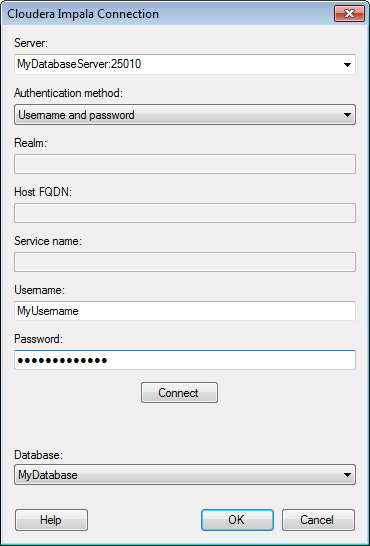
This dialog is used to set up a connection to a Cloudera Impala database, allowing you to choose whether to analyze data in-database or to import it into your analysis. Note that you need to install a driver on your computer to get access to the Cloudera Impala connector. See the system requirements at http://support.spotfire.com/sr_spotfire_dataconnectors.asp to find the correct driver. You can also view Getting Started with Connectors to learn more about getting access to connectors in Spotfire.
To add a new Cloudera Impala connection to the library:
Select Tools > Manage Data Connections.
Click Add New > Data Connection and select Cloudera Impala.
To add a new Cloudera Impala connection to an analysis:
Select File > Add Data Tables....
Click Add.
Select Connection To > Cloudera Impala.

Option |
Description |
Server |
The name of the server where your data is located. To include a port number, add it directly after the name preceded by colon. The default port is 25010. Example with port number: |
Authentication
method |
The authentication method to use when logging into the database. Choose from
|
Realm |
[Only applicable when Kerberos authentication is selected.] The Kerberos realm of the Impala server host. Leave blank if a default Kerberos realm has been configured for your Kerberos setup. For more information about the realm, contact your Cloudera Impala system administrator. |
Host FQDN |
[Only applicable when Kerberos authentication is selected.] The fully qualified domain name of the Impala host. For more information about the service name, contact your Cloudera Impala system administrator. |
Service name |
[Only applicable when Kerberos authentication is selected.] The service name of the Impala server. For example, "impala". For more information about the service name, contact your Cloudera Impala system administrator. |
Username |
The username you wish to use when logging into Cloudera Impala. |
Password |
The password for the specified username. |
Connect |
Connects you to the specified server and populates the list of available databases below. |
Database |
Select the database of interest from the drop-down list. |
See also: